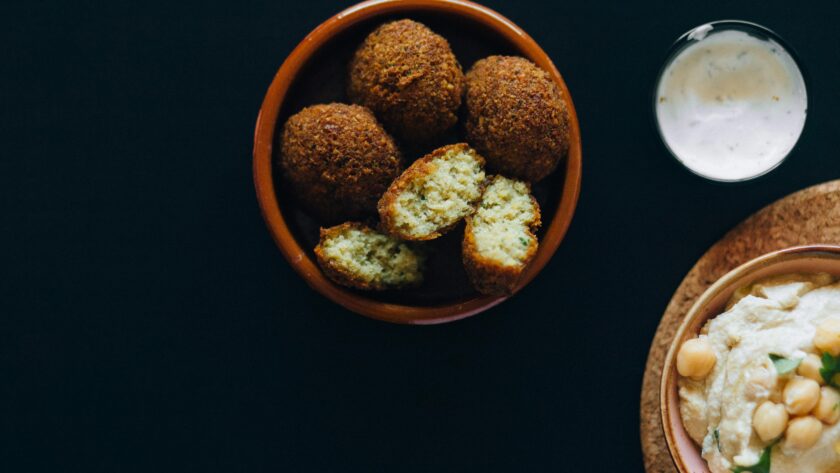If you’re craving a dish that perfectly balances flavor, texture, and nutrition, falafel is the ideal choice. This traditional Middle Eastern snack is not only packed with vibrant herbs and spices but also provides a rich source of plant-based protein and fiber. Whether you’re enjoying falafel on its own, as part of a pita wrap, or alongside a fresh salad, it’s a delicious and healthy option that everyone can appreciate. In this step-by-step recipe, you’ll learn how to make homemade falafel from scratch—crispy on the outside and tender on the inside—using simple, wholesome ingredients. Plus, with this recipe, you can enjoy a guilt-free meal that aligns with vegan, gluten-free, and Mediterranean diets.
Ingredients for falafel
1. Dried Chickpeas (1 cup / 200g):
- Calories: 340 calories
- Protein: 20g
- Fat: 5g
- Carbohydrates: 60g
- Fiber: 16g
Chickpeas are a great source of plant-based protein and fiber, making them a popular choice for falafel. They are rich in antioxidants and vitamins and provide a healthy dose of carbohydrates.
2. Fresh Parsley (1 cup chopped / 60g):
- Calories: 22 calories
- Protein: 2g
- Fat: 0.4g
- Carbohydrates: 4g
- Fiber: 2g
Fresh parsley gives the falafel its signature green color and adds a refreshing, slightly bitter taste. It’s also a source of Vitamin C and K, and antioxidants that help in boosting immunity.
3. Fresh Cilantro (1 cup chopped / 60g):
- Calories: 1 calorie
- Protein: 0.1g
- Fat: 0g
- Carbohydrates: 0.5g
- Fiber: 0.5g
Cilantro pairs wonderfully with parsley, adding citrusy notes and enhancing the flavors of the falafel. It’s also known for its digestive benefits.
4. Onion (1 medium / 150g):
- Calories: 60 calories
- Protein: 1g
- Fat: 0g
- Carbohydrates: 14g
- Fiber: 2g
Onions bring sweetness and depth to falafel. They provide a subtle heat when cooked and are full of sulfur compounds that promote health and add flavor.
5. Garlic (3 cloves / 9g):
- Calories: 13 calories
- Protein: 0.6g
- Fat: 0g
- Carbohydrates: 3g
- Fiber: 0.2g
Garlic is essential for falafel’s bold flavor. It brings a pungent yet sweet taste when cooked and has anti-inflammatory properties, promoting better digestion.
6. Ground Cumin (1 teaspoon / 2g):
- Calories: 8 calories
- Protein: 0.4g
- Fat: 0.4g
- Carbohydrates: 1g
- Fiber: 0.5g
Ground cumin is an important spice in falafel. It adds a warm, earthy flavor and helps in boosting metabolism due to its antioxidant properties.
7. Ground Coriander (1 teaspoon / 2g):
- Calories: 6 calories
- Protein: 0.3g
- Fat: 0.2g
- Carbohydrates: 1g
- Fiber: 0.5g
Coriander seeds have a slightly citrusy, sweet flavor, complementing cumin’s warmth. The combination is classic in Middle Eastern cuisine.
8. Salt (1 teaspoon / 5g):
- Calories: 0 calories
- Protein: 0g
- Fat: 0g
- Carbohydrates: 0g
- Fiber: 0g
Salt enhances the natural flavors of the other ingredients and is essential for balancing the spices.
9. Baking Soda (1 teaspoon / 5g):
- Calories: 0 calories
- Protein: 0g
- Fat: 0g
- Carbohydrates: 0g
- Fiber: 0g
Baking soda helps the falafel maintain its texture and fluffiness when fried, making it light on the inside while crispy on the outside.
10. Lemon Juice (2 tablespoons / 30ml):
- Calories: 8 calories
- Protein: 0.1g
- Fat: 0g
- Carbohydrates: 2.7g
- Fiber: 0.1g
Lemon juice gives the falafel a tangy zing, brightening the earthy flavors. It also helps in digestion and balances the richness of the fried chickpeas.
11. Olive Oil (For Frying, 3 tablespoons / 45ml):
- Calories: 360 calories
- Protein: 0g
- Fat: 40g
- Carbohydrates: 0g
- Fiber: 0g
Olive oil provides healthy fats, contributing to the crispiness of the falafel when deep-fried. It also supports heart health due to its rich monounsaturated fat content.
Total Calories for the Entire Batch of 12 Falafel Balls:
~877 calories
Calories per Falafel Ball: ~73 calories
Instructions for Preparing Falafel
1: Soak the Chickpeas
Start by soaking the dried chickpeas in a large bowl filled with water. Ensure that the water level is several inches above the chickpeas as they will expand during soaking. Let them soak for 12-24 hours. Do not use canned chickpeas for this recipe, as they won’t yield the same texture.
2: Drain and Rinse the Chickpeas
After soaking, drain the chickpeas well and rinse them under cold water. Place the drained chickpeas onto a clean kitchen towel to absorb excess moisture.
3: Process the Herbs and Vegetables
In a food processor, combine the parsley, cilantro, onion, garlic, and fresh herbs. Pulse the mixture a few times to chop it into small pieces. Scrape down the sides of the bowl to ensure even chopping. The mixture should resemble a coarse paste.
4: Blend the Chickpeas
Add the soaked and drained chickpeas to the food processor, along with the ground cumin, ground coriander, salt, and baking soda. Pulse until the chickpeas are finely ground but not turned into a paste. You should still be able to see small bits of chickpeas for texture.
5: Add the Lemon Juice
Add the lemon juice to the mixture, pulsing again to combine. At this point, taste the mixture and adjust the seasoning with more salt or lemon juice if necessary.
6: Rest the Mixture
Transfer the mixture into a bowl and cover it with plastic wrap. Let it rest in the refrigerator for at least 1 hour. Resting the falafel mixture helps it firm up and makes it easier to shape the balls.
7: Shape the Falafel
Once the mixture has rested, use your hands or a falafel scoop to form the mixture into small balls or patties, about 1 to 1.5 inches in diameter. If the mixture is too sticky, wet your hands slightly with water to prevent sticking.
8: Heat the Oil for Frying
In a large pan, heat the olive oil over medium heat. To test if the oil is hot enough, drop a small piece of the falafel mixture into the oil. If it sizzles and rises to the top, the oil is ready for frying.
9: Fry the Falafel
Carefully place the falafel balls into the hot oil, working in batches if necessary to avoid overcrowding the pan. Fry the falafel for about 3-4 minutes per side, or until golden brown and crispy. Use a slotted spoon to remove the falafel from the oil and place them on a plate lined with paper towels to drain excess oil.
10: Serve and Enjoy
Serve your homemade falafel warm, with tahini sauce, in pita bread, or as part of a mezze platter with other Middle Eastern dishes like hummus, tabbouleh, or baba ganoush.
Nutritional Benefits of Falafel recipe
Falafel recipe is a great source of plant-based protein, fiber, and healthy fats, making it a satisfying and filling meal. The combination of chickpeas and fresh herbs provides numerous health benefits, including:
- High Protein Content: The chickpeas and herbs provide a significant amount of protein, making falafel an excellent choice for vegetarians and vegans.
- Rich in Fiber: The dietary fiber from chickpeas and fresh herbs helps promote digestive health, regulate blood sugar, and keep you feeling full longer.
- Antioxidants and Vitamins: Fresh herbs like parsley and cilantro, as well as the addition of lemon juice, provide important antioxidants and vitamins that support overall well-being.
Cooking Tips:
- Baking Option: If you prefer a lower-calorie option, you can bake falafel at 375°F (190°C) for about 25-30 minutes, flipping them halfway through to ensure they are crispy on both sides.
- Serving Variations: Serve falafel in pita pockets with veggies and tahini, or as a topping for salads or grain bowls.
- Freezing: You can freeze uncooked falafel balls. Place them on a baking sheet in a single layer




Leave a Reply